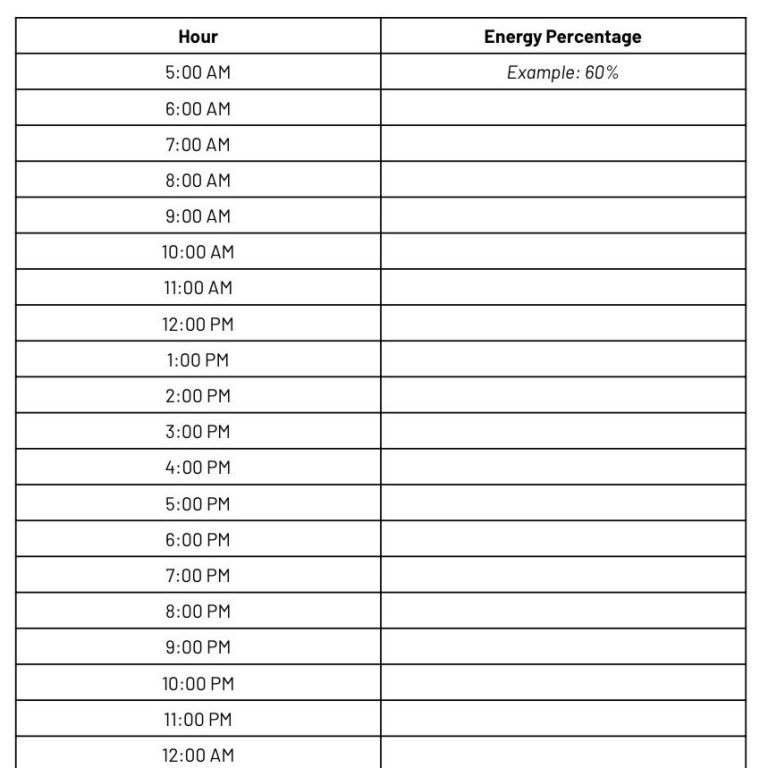Energy Tracking Sheet
Self Help Exercises
It's important to manage your daily life by making good use of your time. the idea that you should prioritize your most crucial work for when you are most attentive and energetic. Utilize this energy monitoring sheet to gain insight into how your energy fluctuates throughout the day.
Note your energy level as a "percentage" each hour. You need should have a solid grasp of the fluctuations in your energy levels after a few days of doing this.

worksheet
Write a paragraph in your journal for each question.
1. How would you define productivity?
2. What does it mean that productivity is getting the RIGHT things done at the RIGH Time?
3. Why is it so important to start with your “Why?” before you start setting goals?
4. What are some of your core values that inform your goal setting?
5. What is the relationship between your core values and the goals you set?
6. What are SMART goals and why are they so important?
7. When was the last time you reviewed your goals to ensure they are in line with your core values?
8. Why is it important to match your tasks with your energy levels?
9. Why should you do the most important, hardest tasks first?
10. How can the Eisenhower Matrix help you prioritize your tasks?
11. What is the advantage of batching similar tasks?
12. What steps can you take to plan for interruptions when you work?
13. Is it hard for you to say “No,” when someone asks you to do something?
14. Why is it essential to be able to say, “No”?
15. What tasks should you delegate?
16. Why is delegation so important?
17. What things distract you during work hours?
18. What steps can you take to reduce distractions?
19. Why is single-tasking an inefficient way of working?
20. How can you optimize your workspace for maximum productivity?
21. How often do you take breaks when you’re working?
22. What is the value of taking breaks?
23. What is the Pomodoro Method and why is it beneficial to productivity?
24. What is time blocking?
25. How can time blocking help you be more effective at work?
Earthing
A Comprehensive Overview
Earthing reconnects humans with the Earth’s natural energy, offering potential health benefits through simple, accessible practices. While research is ongoing, anecdotal and preliminary scientific evidence supports its role in reducing inflammation, improving sleep, and enhancing well-being. Incorporate earthing into daily routines mindfully, prioritizing safety and consistency. Always consult a healthcare professional for personalized advice.
Health Benefits of Earthing
- Reduced Inflammation: Neutralizing free radicals may lower inflammation, linked to conditions like arthritis and heart disease.
- Improved Sleep: Studies suggest earthing normalizes cortisol rhythms, enhancing sleep quality and regulating circadian cycles.
- Pain Relief: Reduced inflammation and muscle tension can alleviate chronic pain and speed recovery post-exercise.
- Stress Reduction: Activates the parasympathetic nervous system, lowering stress hormones like cortisol.
- Enhanced Circulation: May improve blood flow by reducing viscosity, supporting cardiovascular health.
- Mood Improvement: Lower stress and better sleep often correlate with reduced anxiety and depression symptoms.
How to Practice Earthing
- Duration: Aim for 20–60 minutes daily. Even short sessions (e.g., 10 minutes) can offer benefits.
- Frequency: Daily practice is ideal. Consistency enhances cumulative effects.
- Locations:
- Natural Surfaces: Walk barefoot on grass, soil, sand, or swim in natural bodies of water.
- Urban Alternatives: Use grounding mats, sheets, or bands indoors (connected via an earthing outlet or rod).
- Footwear: Leather soles or specially designed earthing shoes can work, but rubber soles insulate.
Earthing is not a substitute for medical treatment but may complement conventional therapies.


Guided Imagery Reprocessing
Best Practices for Healing
Guided imagery reprocessing involves intentionally revisiting a traumatic memory in a safe, controlled way to process unresolved emotions, reframe the experience, and promote healing.
Step-by-Step Process
1. Set Intentions:
- Clarify your goal (e.g., “I want to understand my pain and release its hold on me”).
2. Create Safety:
- Choose a quiet, private space. Use comforting objects (a blanket, calming music).
- Mentally visualize a “safe container” to hold difficult emotions.
3. Ground Yourself:
- Begin with 5 minutes of deep breathing or progressive muscle relaxation.
4. Revisit the Memory Gradually:
- Approach the memory in small “doses” rather than reliving it all at once.
- Use dual awareness: Observe the memory while staying connected to the present (e.g., “That happened then, but I’m safe now”).
5. Mindful Observation:
- Notice sensations, emotions, and thoughts without judgment. Ask:
- “What does my body feel right now?”
- “What did younger me need in that moment?”
6. Reprocess the Memory:
- Reframe the Narrative: Rewrite the story with empowerment (e.g., “I survived, and I’m strong”).
- Visualize Support: Imagine a protector (your present self, a loved one, or a symbolic figure) intervening in the memory.
- Somatic Release: Shake, cry, or move to discharge trapped energy (common in somatic therapy).
7. Close the Session:
- Return to grounding. Thank yourself for your courage.
- Write or draw to integrate insights.
Risks & Cautions
- Avoid Retraumatization : If you feel overwhelmed (panic, dissociation), stop and return to grounding.
- Don’t Go Alone: Severe trauma (e.g., PTSD) requires professional support.
- Patience: Healing is non-linear; progress may feel slow.
Eclipse Essence
© Copyright. All rights reserved.
We need your consent to load the translations
We use a third-party service to translate the website content that may collect data about your activity. Please review the details in the privacy policy and accept the service to view the translations.